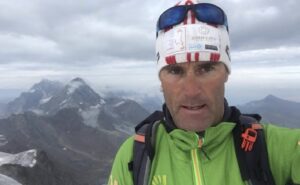Kangchenjunga (8,586m) was climbed for the first time exactly 68 years ago. Today, a group of climbers summited in what was surely an incidental anniversary celebration.
The Western climbers were Adrian Laza of Romania, Vadim Druelle of France, Vibeke Sefland of Norway, He Jing of China, Waldemar Kowalewski of Poland, Flor Cuenca of Peru, and Luis Stitzinger of Germany. Their Nepali guides were Pemba Sherpa, Nuri Sherpa, Chhepal Sherpa, Chhiring Bhote, and Ang Tenji Sherpa.
Some of them had not used bottled oxygen on previous 8,000m ascents. We’ve yet to learn how many did not use it on Kangchenjunga, although ski mountaineering guide Vadim Duelle confirmed that he was one of these. He also climbed non-stop from Base Camp to the summit in 22 hours.

Vadim Druelle some days ago at Kangchenjunga’s Base Camp. Photo: Vadim Druelle/Instagram
Outfitted by Seven Summit Treks, this is the second team to summit Kangchenjunga this season. Kristin Harila and her guides did so last weekend.
In fact, some of today’s summiters were also with Harila. However, they turned around when they followed the rope-fixing team up the wrong couloir. Meanwhile, Harila and her guides broke off from the larger group and went up the right way.
Experienced 8,000m climbers
Some climbers in today’s summit group reached Base Camp just a couple of days ago. This includes Flor Cuenca and also Chhepal Sherpa with Vibeke Sefland. These two already summited Annapurna and Dhaulagiri together this season.
Most members of the team had considerable previous experience. Kangchenjunga was Flor Cuenca’s 6th 8,000’er, all without O2. Stitzinger has climbed nine of them without oxygen. He has also made some spectacular ski descents.
Others did not make it to Base Camp in time to take part in this week’s push. Grace Tseng abandoned her Everest attempt only yesterday and hopes to climb Kangchenjunga before the season ends.

Chhepal Sherpa and Vibeke Sefland after summiting Dhaulagiri four days ago. They were en route to Kangchenjunga, which they successfully climbed today. Photo: Chhepal Sherpa/Instagram
First ascents
Joe Brown and George Band of the UK made the first ascent of Kangchenjunga on May 25, 1955. Norman Hardie and Tony Streather followed them the next day, according to mountain blogger Bob A. Shelfhout.
As he also noted, the climbers respectfully stopped a couple of meters below the top, to honor a promise that expedition leader Charles Evans made to the king of Sikkim. The summit was a sacred spot to the local people. Later climbers kept the tradition alive for years. With the coming of the large commercial teams, the habit has fallen away of late, as pictures show.






